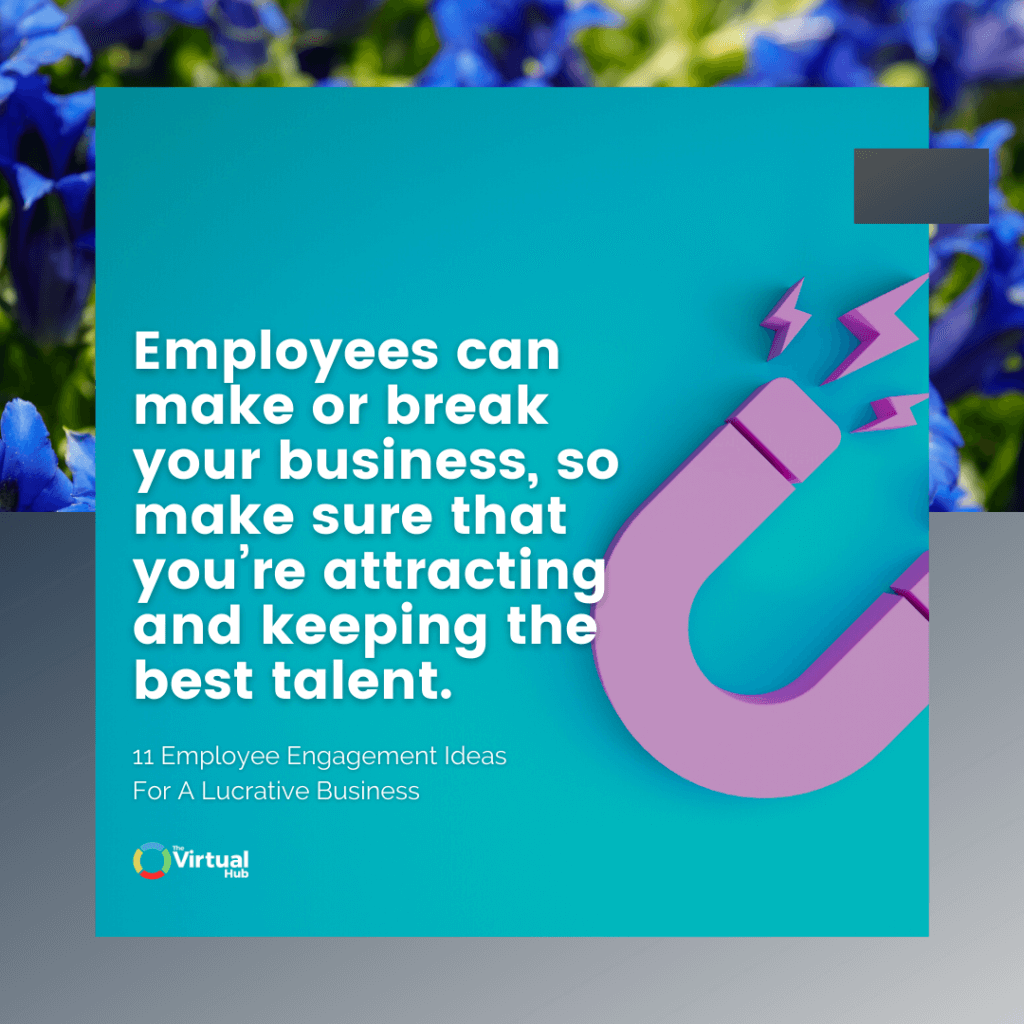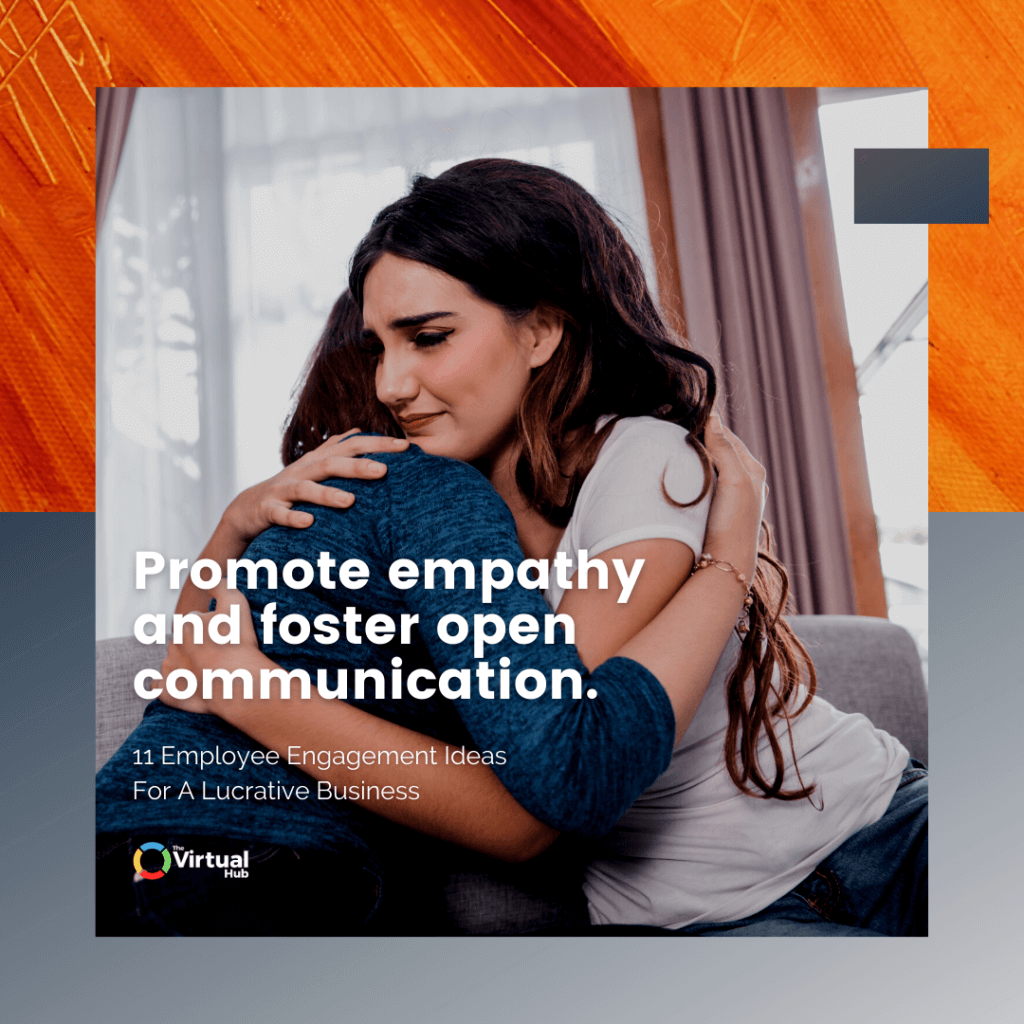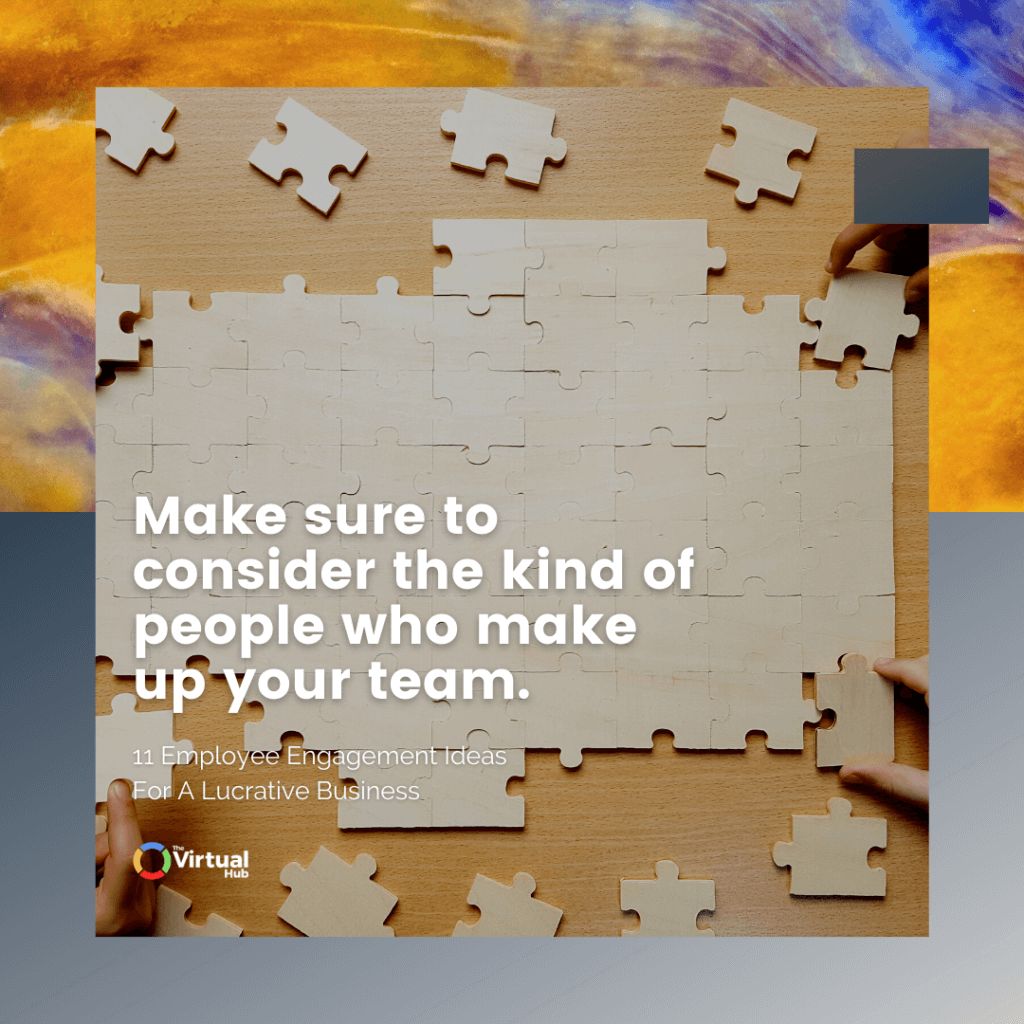Your employees can make or break your business, so you want to make sure that you’re attracting and keeping the best talent.
Luckily, employee engagement strategies can help with this. By keeping employees engaged and happy, you’ll have a more productive and positive work environment.
Here are 11 employee engagement strategies to get you started!
RELATED: Operationalizing Purpose & Culture For Tangible Results
You can click on these links below to jump to a specific topic:
- About Employee Engagement
- Defining the Company Culture, Vision, and Core Values
- Developing a Long-Term Employee Engagement Program
- Redefining Meetings
- Promoting Empathy
- Fostering Open Communication
- Shaking Things Up
- Rewarding and Recognizing Good Employee Performance
- Prioritizing Employees' Career Development
- Avoiding Micromanaging
- Freeing Up Their Time
- Offering Meaningful Perks
Effective Employee Engagement Strategies You May Use in Your Business to Boost Employee Productivity
About Employee Engagement
So, what exactly is employee engagement? It's a bit hard to define, but we know it when we see it.
Employee engagement is about so much more than just employee satisfaction. It describes the level of an employee's connection to and involvement in their work. It's about being emotionally and mentally invested in their work and in your company. It's about feeling like they have a stake in the success of your business, and that their work matters.
Engaged employees feel valued. Because of this, they become more productive, more creative, and more focused. They have a sense of ownership over their work and are committed to achieving their goals. They also have a positive attitude and take pride in their work.
Employees engaged are the ones who come to work every day with a smile on their face, ready to take on whatever the day brings. They're passionate about their work and committed to making a difference.
Ultimately, high employee engagement is important because it leads to better performance and increased levels of productivity. What's more, organizations can retain employees and top talent, as well as improve their morale, when businesses place an importance on employee engagement.
So, how do you create an engaged workforce?
There are many ways to boost employee engagement, but some of the most effective include:
1. Defining the Company Culture, Vision, and Core Values
Employee engagement will look different from one company to another. That’s because each company has a unique mission statement. Your company core values, culture, and vision will shape a successful employee engagement strategy.
So before you get into the hows of employee engagement, you need to understand your whys. Once you know what you want your entire company to look like and stand for, you can start working towards it.

This is especially useful in the hiring process. When there’s clarity in your company's values and organizational culture, you can include them in your hiring criteria.
It’s also very helpful for a new employee to understand how their jobs contribute to the company’s short-term and long-term goals. Team members are more motivated when they understand how valuable their roles are.
This isn’t just important for new employees though. Every team member can benefit from a vision refresher. This is especially true for remote team members whose roles have evolved through the years.
2. Developing a Long-Term Employee Engagement Program
Before outlining a program, it helps if you define what employee engagement means for your organization.
You can’t achieve lasting employee engagement with a single team-building activity. If you want to boost engagement, you need a sustainable, long-term program that will help keep your team members focused and motivated.
As your employees’ needs evolve, your program should evolve as well. So try to find out what your team members are passionate about. That way, you can tailor-fit the employee engagement ideas to your company.
Pro Tip: Your employee engagement strategy should start during the onboarding process. You can assign a mentor or a peer buddy to help newcomers acclimate to their new workplace and colleagues.



3. Redefining Meetings



Meetings don’t have to be boring routines! They can be a great avenue to exercise creativity and engage employees.
Traditional, agenda-filled meetings can be draining if they happen too often. And when team members are disengaged, these meetings can quickly turn into a waste of time.
Here are a few ideas on how you can redefine meetings:
Experiment with Meeting Size
It’s easier to exercise flexibility when you’re meeting with smaller groups of people. When working with small groups, you can structure the meeting based on their strengths or working styles.
If you’re managing a large team, try breaking them up into smaller groups. You can also create task forces to work on specific projects. This way, your team members can share their knowledge with each other more effectively.
Encourage Discussion and Brainstorming
Meetings are often more engaging when there’s room for discussion and brainstorming. And when employees feel engaged, they’re more likely to share new ideas.
You can start by encouraging employees to speak up and share their opinions. Try asking open-ended questions that don’t have easy answers. You can also use brainstorming techniques like round robin or brainwriting to get everyone’s ideas out in the open.
Try Problem-Solving Meetings
In problem-solving meetings, team members are encouraged to work together to find solutions. These types of meetings are less structured and more free-flowing. It helps drive employee engagement and collaboration.
Let Someone Else Take the Lead
Let someone else run the weekly meeting to shake things up. It’s also a great way to help train employees and potential leaders in your team.
4. Promoting Empathy
Empathy allows you to imagine yourself in someone else’s situation. It’s especially valuable in the workplace because it helps minimize conflict and promotes compassion.
If empathy permeates the workplace, it’ll be easier for your employees to build a community. They’ll know that in each interaction, regardless of rank, they’ll be treated with respect.
If you sense that there’s an empathy problem in your office, try the “day in the life” activity. In this activity, you get different employees to switch roles for a day.
"Empathy allows you to imagine yourself in someone else’s situation."
5. Fostering Open Communication
Communication issues can pop up in any working environment, and these problems can block employee engagement. This is why one of the most important aspects of promoting open communication in your workplace is empowering employees to speak up.
Here are some ways to do that:



Encourage Questions
Don’t view questions as a sign of ignorance. Instead, encourage employees to ask questions so that they can understand the task at hand better.
Define Internal Communication Channels
Make sure your employees know the best way to communicate with one another. For example, some matters are best discussed through face-to-face interactions while others can be hashed out via chat or email.
Keep Them in the Loop
Give them inside information when you can. This shows that you trust them. You also never know what insights your employees may be able to provide in a certain situation.
Gather Employee Feedback
Give your employees different opportunities to provide their feedback. It’s also equally important to respond to the feedback. Even if you don’t act on it the way they want to, your employees need to see that you’ve considered their input.
Offer Clear, Actionable Feedback
When giving feedback, make sure it’s specific and timely. For feedback to be actionable, it has to be about something within your employee’s control.
Make Communication a Two-Way Street
Encourage employees to communicate with one another. But more importantly, listen to what your employees have to say. Not only will this help you resolve any issues, but it’ll also show your employees that their voices are heard.
Promote Openness
Lead by example and be open with your team members. When you’re more open with them, they’ll be more likely to share their own thoughts and ideas.
Value Different Perspectives
When you value different perspectives, it shows in the way you communicate with your team. Avoid making assumptions and give employees the benefit of the doubt. Try to see things from their point of view.
Pro Tip: If you’re dealing with a diverse group of people, it might be helpful to come up with a communications policy.
RELATED: 4 Ways To Build A Positive Work Culture With Your Virtual Team
6. Shaking Things Up
Routines make it easy to disengage and go into auto-pilot. So shake things up now and then!
Here are few fun, short-term employee engagement activities you can try:
No Emails and Instant Messaging for One Day
Choose a non-critical day to ban emails for an entire workday. If your employees need to communicate with one another, they have to talk to each other.
Play Some Music
Do you notice regular morale dips? Is it first thing on Monday? Maybe hump day? Whenever it is, play a song or two as a quick pick-me-up. Take requests once a month and choose the song lottery-style!
Bond with Food
Every week, assign one employee to bring their favorite snacks to work for sharing. Have them explain why it’s their favorite. This is a great way for employees to get to know one another.
Do a “Dress-up” Day
Encourage employees to come to work dressed up as their favorite book character, movie star, or TV show personality. You can even do this virtually!
Volunteer Together
Find a cause that your team is passionate about and take a day off to volunteer together. This can help build camaraderie between team members.
Have a Picnic
If the weather permits, have a picnic lunch in the park! This can help your employees to relax and enjoy each other’s company.
Pro Tip: Make sure to consider the kind of people who make up your team. What may be engaging for some people can be off-putting for others.



RELATED: Learn How to Be Productive With These 10 Simple and Easy Tips
"Make sure your employees know the best way to communicate with one another."
7. Rewarding and Recognizing Good Employee Performance



Motivate and inspire employees by rewarding good performance and having an employee recognition program. Your appreciation and rewards can reinforce behavior you want other employees to emulate.
It’s important to have a value-based employee recognition and reward system that everyone can participate in. You can also congratulate your employees on personal or family achievements.
Remember, many employees can get burned out when they don’t receive positive feedback, praise, or recognition. And when employees burn out, they’re less engaged and don’t perform as well.



8. Prioritizing Employees' Career Development
Here are a few things you can do:
- Provide regular training or professional development opportunities.
- Provide opportunities for lateral movement.
- Encourage coaching.
- Make room for personal projects.
Your business can also benefit from more skilled employees! Employee development can increase your business’ human capital which, in turn, makes your business more valuable.
9. Avoiding Micromanaging
Constantly checking on your employees communicates that you don’t trust them. And it is difficult to feel engaged in a workplace where you don’t have any control.
A little employee autonomy goes a long way. It gives them the space to try out different strategies. In the long run, they’ll have more ownership of their work.



So instead of giving them a list of tasks to accomplish, assign them key responsibilities. This gives them a sense of purpose and heightens engagement.
10. Freeing Up Their Time
Everyone gets bogged down by repetitive administrative tasks. These are hours that your employees could spend engaged in work that they enjoy and excel in.
So try to figure out if there are unnecessary tasks you can take off their plate. That way, you give them more time to focus on the work that could truly help you grow your business.
Pro Tip: Consider outsourcing administrative tasks to virtual assistants. Virtual assistants help free up time by taking over routine administrative tasks.



11. Offering Meaningful Perks



Perks are great external motivators. An enticing perk may help your employees improve their performance or hit their targets quicker. Many businesses offer regular perks like company swag, but you can maximize this strategy by figuring out what matters to your employees.
For example, if many employees value work-life balance, then you may want to offer perks that promote this like extra vacation days or more flexible schedule options.
Meanwhile, if health and fitness are a common goal among your employees, you may try offering wellness programs or gym memberships.
Pro Tip: If you're handling a large group of people, HR might be able to help out! They can conduct an initial employee engagement survey to see which perks excite your employees the most.



Final Thoughts
Employee engagement is essential to the success of any business. After all, engaged employees are more productive and have a positive impact on company culture. A positive work environment does not only lead to higher job satisfaction, better employee retention, and higher customer satisfaction, but it can ultimately contribute to your bottom line.
There are many things you can do to encourage employee engagement. But it’s important to remember that every business is different. And what works for one company may not work for another.
The best way to find out what will work for your business is to experiment with different employee engagement ideas. Keep track of what works and what doesn’t. Over time, you should be able to find a system that helps you get the most out of your employees!
Up Next:
